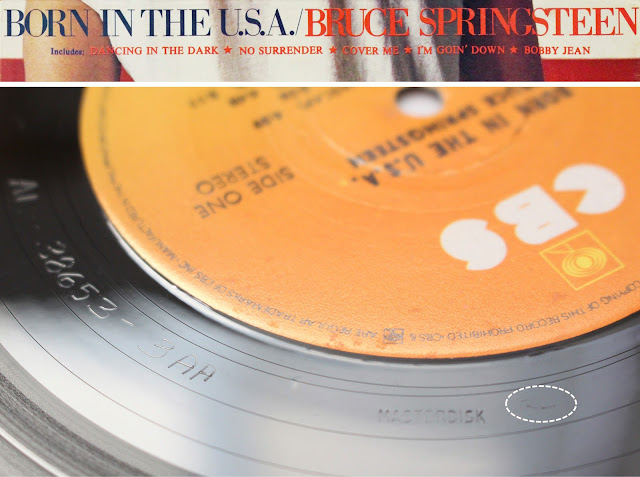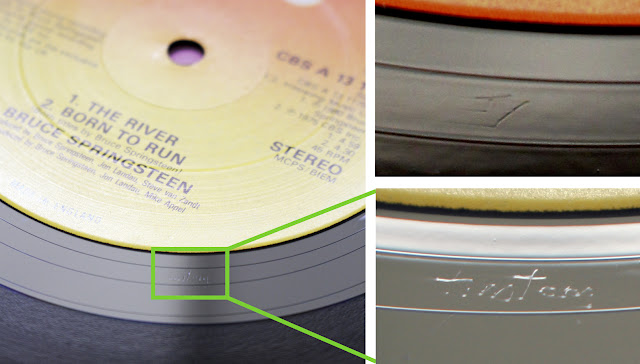 |
Another flawed copy of the album from my
collection is the U.K. first pressing, as indicated
by the matrix number CBS-86304-A1, which
comes with the blank label on Side One. |
As mentioned in the last post, the original or early copies of
BORN IN THE U.S.A. LP (
Columbia QC 38653) manufactured in the U.S. have wide deadwax on
Side One, which in addition to the matrix hand-etching
RL, is a feature associated with the vinyl pressings mastered by
Robert "Bob" Ludwig at
Gateway Mastering Studios, Portland, ME. On the other hand, the later pressings with narrow deadwax, where his initials are absent, are not cut by this
Mastering Maestro, despite whom the album production credits refer to as mastering engineer on the album inner sleeve. This fact just made me wondering about the deadwax width of various copies of the album pressed in countries other than the U.S. Here for making comparison, I picked up several of the copies randomly from my collection.
 |
| Two horizontal dashed lines of green color on top of the image indicate the width of deadwax space of the early U.S. pressing. Not sure if the Italian and Mexican copies shown here correspond to a very early pressing released in each country (matrix numbers are CI 86304-1L-16-5-84 and 50-04-16122-1B-1, respectively, on Side One). |
Initially, I thought that the "wider deadwax" pressings were confined to the early U.S. copies with the matrix
RL inscription because
Ludwig had nothing to do with lacquer master cutting for non-U.S. pressings (
i.e., mastering and cutting of the lacquers for vinyl pressing were done independently in individual countries after master recording tapes were received from the
US Columbia Records). In fact, as shown above, the (supposedly early) copies released in the
U.K.,
Italy, and
Mexico show variation in deadwax space with narrow width. [By the way, in Japan and probably in other countries, Direct Metal Masters (DM or DMM) were used instead of master recording tapes for pressing the subsequent two albums,
LIVE/1975-85 (
Columbia C5X 40558) and
TUNNEL OF LOVE (
Columbia OC 40999). So, there are probably no differences
in the deadwax width (and sound quality) between non-U.S. and U.S. pressings for these
albums. The deadwax of such pressings is commonly inscribed with
MASTERDISK which often accompanies a
DM or
DMM hand-etching.]
 |
Both Filipino and Dutch pressings carry a MASTERDISK stamp on each side of deadwax space, an indication of the U.S. origin of master lacquers that were utilized for vinyl pressing in these countries.
|
 |
Upper: The Filipino LP is known for the modified front sleeve that
uses orange fonts for artist name and additionally mentions
five featured tracks beneath the album title/artist.
Lower: The deadwax carries the matix number information
just like that of the early U.S. pressings
(RL inscription is encircled). |
Contrary to my thoughts, however, "wider deadwax" pressings do exist, except for the U.S. release. The composite image right above shows
Dutch,
Filipino, and ex-
East German pressings whose deadwax space is comparable in size to or even wider than that of the early U.S. copy. Notably, the Made-In-Philippines disc is machine-stamped with
MASTERDISK and inscribed with
RL in addition to the unique
Filipino-specific codes with the prefix
QCL (see below). According to
Discogs, there is a U.S. (
Pitman factory) pressing with the same matrix numbers (suffixes,
-3AA/
-2AL; both stamp and initials present), indicating that the lacquers, metal mothers, or stampers were most probably imported from the U.S.
Side One: P AL-38653-3AA MASTERDISK RL QCL-22110-A
Side Two: P BL-38653-2AL MASTERDISK RL QCL-22110-B
(hand-etched,
italics; stamped, upright font)
 |
| What does the inscription NL refer to? Initials for an unknown mastering engineer? Nah, I guess Netherlands (totally no evidence, though). BTW, my Dutch copy comes with a red sticker which is specific to the initial pressing? |
The
Dutch pressing also has the machine stamp, but instead of
Ludwig's initials, a two-letter code,
NL, is inscribed on both sides of record's trail-off area. It may represent the initials of yet unknown mastering engineer who did cut this Dutch pressing. I suppose a different case: the
U.S. Columbia Records (hence,
Bob Ludwig or his colleague at
Gateway Mastering Studios) prepared lacquers, mothers, or stampers specially for the Dutch pressing, just because of my speculation that the two matrix inscriptions,
INT and
NL, could mean "
International" and "
Nether
Lands," respectively. No evidence and pure speculation, though.
Side One: B PAL-38653-INT MASTERDISK NL 01-86304-4A-1
A
Side Two: A PBL-38653-INT MASTERDISK NL 01-86304-6B-1
The ex-
East German disc, on the other hand, has obviously no relation to the U.S. pressings in terms of master cutting, as it has machine-stamped unique matrix numbers (
8 56 222-1B I 86 I C/
8 56 222-2A I 86 I C for my copy).
Then, how about the Japanese pressings?
— To be continued.

































